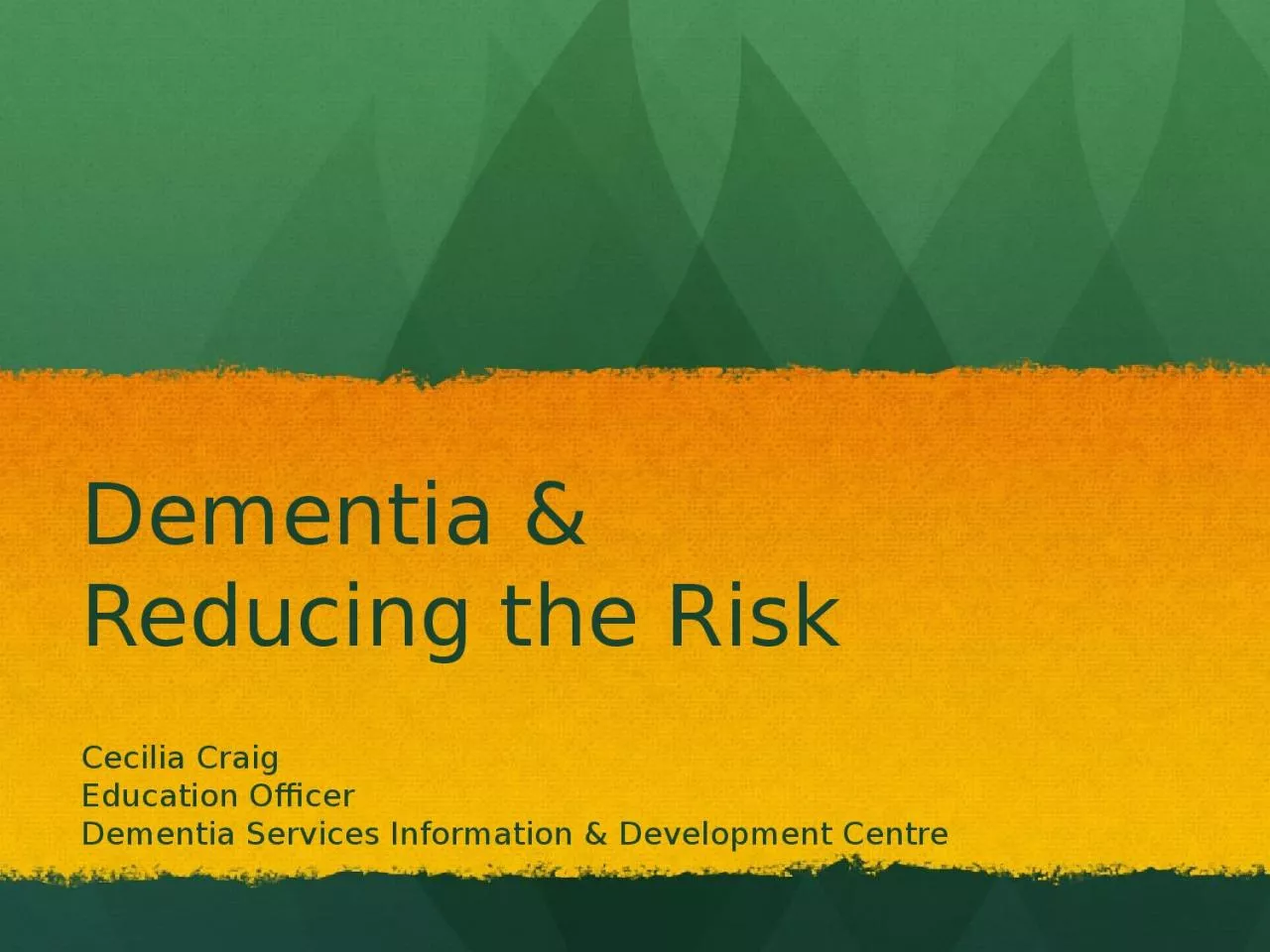

Cecilia Craig Education Officer Dementia Services Information amp Development Centre Alzheimers Disease 60 Korsakoff s Dementia Vascular Dementia 20 Lewy Body Dementia 15 ID: 1045193
Download Presentation The PPT/PDF document "Dementia & Reducing the Risk" is the property of its rightful owner. Permission is granted to download and print the materials on this web site for personal, non-commercial use only, and to display it on your personal computer provided you do not modify the materials and that you retain all copyright notices contained in the materials. By downloading content from our website, you accept the terms of this agreement.
1. Dementia & Reducing the RiskCecilia CraigEducation OfficerDementia Services Information & Development Centre
2. Alzheimer's Disease (60%)Korsakoff’s DementiaVascular Dementia (20%)Lewy Body Dementia (15%)AIDS Dementia ComplexFrontotemporal lobe: Pick’s Disease Creutzfeldt-Jakob DiseaseCommonLess common10%90%% Approx
3. DEMENTIA IS …Any disorder causing brain destruction …… leading to functional loss of those cells.Results in difficulties in:CognitiveSocialPhysical activities of daily living.A gradual process usually.
4. DEMENTIA IS …A disability characterised by:Impaired Memory Impaired ReasoningImpaired Ability to LearnHigh Level of StressAcute Sensitivity to Social & Built Environment (Marshall, M. 1997)
5. What is affected?Physical abilities:EatingDrinkingMovingSleepingWalking etc..
6. What is affected?Thinking abilities:RememberingReasoningThinkingPlanningJudgementCalculationProblem solvingConcentration
7. What is affected?Social abilities:Communicating with othersMaintaining relationshipsWork performanceSocial etiquette
8. What are the Risk Factors for Dementia?
9. FAMILY History AGEGENETICGENDERMEDICAL Conditions LIFESTYLE
10. As you age – the risk increasesAGE
11. A family history increases the riskFAMILY HistoryEthnicity: – Sth. Asian and African-Caribbean originIncreased risk for …vascular diseases and diabetes.
12. GeneticRARELY…Certain genes increase the risk:Presenilin 1, 2 & APP genes (significant)ApoE4 on chromosome 19 (high)Down syndrome (high)
13. Vascular disease Repeated head injuries Diabetes Type 2 Depression Others e.g. Parkinson, MS … all increase the riskMEDICAL Conditions
14. Females are slightly more at risk GENDER
15. Diet - cholesterol - vitamin D etc…Social isolationSedentary LifestyleAlcoholSmokingLIFESTYLE
16. How can the risk be reduced?Video
17. Challenge yourselfChange something in your lifeLearn something new A languageGuitarRoutineJoin ToastmastersVisit new placesParachute from a plane
18. Exercise Healthy Diet Socialise RunWalkSwimLow fatFruit & VegLow alcohol & no smokingMeet peopleEngage in social activities
19. Stress Sleep Rest7-8 hrs sleepMental & Physical RestImprove Coping SkillsEliminate Stressors
20. Reduce your RISKIncrease your RESERVERemember …
21. TYPES …Alzheimer’s type dementia (50-70%)Vascular dementia (10-20%)Mixed dementia (15-20%)Lewy Body dementia (15%)Other (10%)
22. Alzheimer’s DementiaCause – unknown, insidious onset & gradual progression.Memory impairment.Impairment of 1 or more of the following: -Aphasia - Agnosia - ApraxiaDisturbances in executive functionBiopsychosocial approach.
23. Vascular DementiaInterrupted blood supply to the brain.Death of brain cellsRisk associated with:Cardiovascular disease & diabetesMemory impairment – not always the first sign.Reduced ability to concentrate.Personality may be unaffected.Insight may be present for much longer.Depression is not uncommon.
24. Lewy Body DementiaSimilar to other dementias.Cardinal symptoms:Fluctuating decline in cognition and function.Visual hallucinations.Parkinson’s characteristics.Sensitivity to antipsychotic medications.Other features:Transient loss of consciousness – falls.Depression & Daytime sleepiness.
25. Frontotemporal Dementia (<60)Most common < 60yrs & strong family link.Frontal and anterior temporal lobes:Reason, personality, movement, social etiquette, language & some aspects of memory.Changes in personal & social behaviour:Loss of inhibition.Apathy & Social withdrawal.Hyperorality (mouthing of objects).Ritualistic compulsive behaviours.Loss of moral reasoning & sense of self.
26. LESS COMMON DEMENTIAS Parkinson’s DiseaseAlcohol related (Korsakoff’s Disease)Creuzfeldt-Jakob DiseaseHIV/AIDS relatedDementia in people with an intellectual disability – Down Syndrome
27. FACTS ABOUT DEMENTIACurrently 55,000 in IrelandDouble in 20 yrs – 95,000 (Cahill et. al., 2013 – estimation)Stigma associated with dementia.Lack of knowledge & information.Cost of dementia in Ireland - €1.7b (O’Shea, 2007)
28. GLOBAL FACTS44 million around the world (Alzheimer International, 2013) Two thirds in developing countries.Prevalence is 5% - 12% in people over 65.The prevalence will increase due to ageing populations and longer life spans.